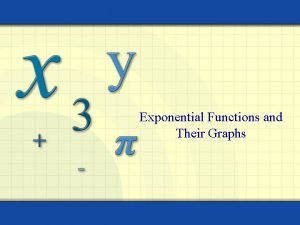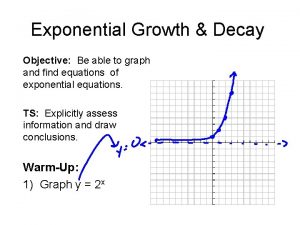4 3 GRAPHS OF EXPONENTIAL FUNCTIONS 1 Graphs







- Slides: 7

4. 3 GRAPHS OF EXPONENTIAL FUNCTIONS 1

Graphs of the Exponential Family: The Effect of the Parameter a In the formula Q = abt, the value of a tells us where the graph crosses the Q-axis, since a is the value of Q when t = 0. Q=150 (1. 2)t Q=50 (1. 4)t Q=50 (1. 2)t Q=100 (1. 2)t Q=50 (0. 8)t Q=50 (1. 2)t Q=50 (0. 6)t 2

Graphs of the Exponential Family: The Effect of the Parameter b The growth factor, b, is called the base of an exponential function. Provided a is positive, if b > 1, the graph climbs when read from left to right, and if 0 < b < 1, the graph falls when read from left to right. Q=50 (1. 4)t Q=50 (1. 2)t Q=50 (0. 8)t Q=50 (0. 6)t 3

Horizontal Asymptotes The horizontal line y = k is a horizontal asymptote of a function, f, if the function values get arbitrarily close to k as x gets large (either positively or negatively or both). We describe this behavior using the notation f(x) → k as x → ∞ or f(x) → k as x → −∞. Alternatively, using limit notation, we write 4

Interpretation of a Horizontal Asymptote Example 1 A capacitor is the part of an electrical circuit that stores electric charge. The quantity of charge stored decreases exponentially with time. If t is the number of seconds after the circuit is switched off, suppose that the quantity of stored charge (in micro-coulombs) is given by Q = 200(0. 9)t, t ≥ 0. The charge stored by a capacitor over one minute. Q, charge (micro-coulombs) t (seconds) 5

Solving Exponential Equations Graphically Exercise 42 The population of a colony of rabbits grows exponentially. The colony begins with 10 rabbits; five years later there are 340 rabbits. (a) Give a formula for the population of the colony of rabbits as a function of the time. (b) Use a graph to estimate how long it takes for the population of the colony to reach 1000 rabbits. Solution Solving 340 = 10 b 5 we get b 5 = 34, b = 2. 0244, R ≈ 10 (2. 0244)t Based on the graph, one would estimate that the population of rabbits would reach 1000 in a little more than 6 ½ years. 6

Finding an Exponential Function for Data Example: Population data for the Houston Metro Area Since 1900 Table showing population (in thousands) since 1900 t 0 10 20 30 40 50 N 184 236 332 528 737 1070 t 60 70 80 90 100 110 N 1583 2183 3122 3733 4672 5937 Graph showing population data with an exponential model P (thousands) 6000 P = 190 (1. 034)t 5000 4000 3000 2000 1000 t (years since 1900) 0 0 20 40 60 80 100 Using an exponential regression feature on a calculator or computer the exponential function was found to be P = 190 (1. 034)t 7
 Exponential functions and their graphs
Exponential functions and their graphs End behavior chart
End behavior chart Exponential growth and decay graphs
Exponential growth and decay graphs Linear quadratic and exponential graphs
Linear quadratic and exponential graphs How to tell if a graph is linear quadratic or exponential
How to tell if a graph is linear quadratic or exponential Transformations in exponential functions
Transformations in exponential functions Graphs that enlighten and graphs that deceive
Graphs that enlighten and graphs that deceive State graphs in software testing
State graphs in software testing













